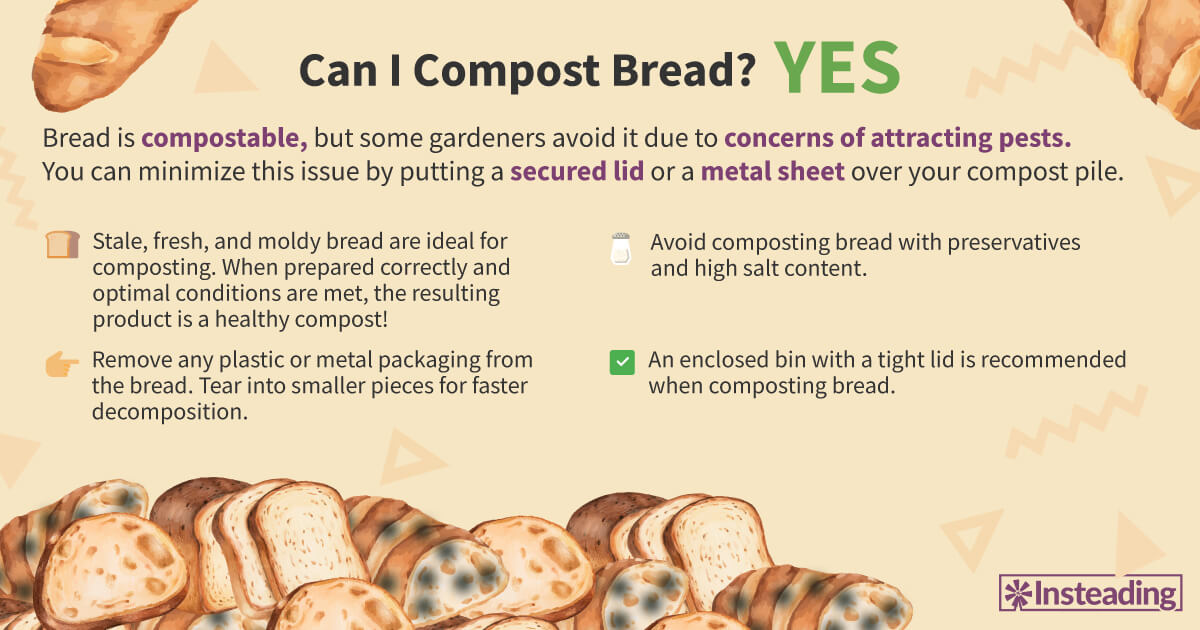Can I Put Moldy Bread in Compost? Essential Tips for Successful Composting

Composting is an eco-friendly way to recycle organic waste and enrich soil, but not every food item is suitable for this process. A common question arises: Can I put moldy bread in compost? While moldy bread may seem like a waste, it can contribute to compost if managed properly. Understanding the nuances of composting moldy bread is essential for maintaining a healthy compost pile. In this article, we will explore the benefits and drawbacks of composting bread, how to do it safely, and essential tips to ensure your compost remains balanced and effective. Embrace composting with confidence and creativity!
Is Moldy Bread Safe for Composting?
Yes, you can put moldy bread in compost, as mold is a natural part of the decomposition process and can contribute beneficial microbes to your compost pile. However, it is essential to ensure that the amount of moldy bread you add is moderate, as excessive amounts can lead to an imbalance in your composting system, potentially attracting pests or creating unpleasant odors. When adding moldy bread, be sure to incorporate it well with other green and brown materials to promote aeration and balanced decomposition.
Benefits of Composting Moldy Bread
Composting moldy bread offers several benefits, such as enriching the compost with vital nutrients, enhancing microbial activity, and improving soil quality. Mold breaks down organic matter effectively and aids in the breakdown of other materials in the compost, thus supporting the overall composting process. Additionally, moldy bread is high in carbohydrates, which can boost the energy content of the compost, making it a valuable addition to both home gardens and larger agricultural operations.
Potential Risks of Composting Moldy Bread
While composting moldy bread can be beneficial, there are some potential risks involved. If large quantities of moldy bread are added, it can create a sour environment that may slow down decomposition and lead to unpleasant odors. Furthermore, some molds may produce mycotoxins that can be harmful to certain animals, although they are generally not a concern in a well-maintained compost pile. It is crucial to monitor the composting process to ensure a healthy and balanced environment.
How to Compost Moldy Bread Properly
To compost moldy bread effectively, start by cutting it into smaller pieces to increase the surface area and promote faster decomposition. Mix the bread with a good balance of greens (like grass clippings or vegetable scraps) and browns (such as dried leaves or cardboard) to maintain proper aeration and moisture levels. Regularly turning the compost pile is important to keep the process active and ensure even decomposition throughout the pile.
What Types of Bread Are Suitable for Composting?
Most types of moldy bread are suitable for composting, including white, whole grain, and pastas that have mold growth. However, it is best to avoid processed breads containing additives or preservatives that may not break down easily. Additionally, bread with a high sugar content or excessive frosting can lead to gumminess in compost, causing clumping and hindering the aeration process. To ensure the health of your compost, opting for more natural bread varieties is advisable.
How Much Moldy Bread Can You Add to Your Compost?
The quantity of moldy bread you can add to your compost largely depends on the size of your compost pile and the other materials you are using. A general rule is to limit moldy bread to about 10-20% of your total compost volume to maintain balance and avoid attracting unwanted pests. It’s important to ensure that the bread is well-mixed with other organic materials to prevent clumping and to support a healthy decomposition process.
| Aspect | Detail |
|---|---|
| Benefits | Enriches nutrients, promotes microbial activity. |
| Risks | May attract pests, create odors if excessive. |
| Best Practices | Mix with greens and browns, cut into pieces. |
| Types of Bread | Avoid processed or sugary varieties; prefer natural breads. |
| Quantity | Limit to 10-20% of total volume. |
Can I put moldy bread in the compost?

Yes, you can put moldy bread in the compost. In fact, bread is considered a biodegradable material, and its breakdown contributes to the formation of rich compost. Mold itself is not harmful when introduced in moderation, as it can actually aid in the decomposition process by promoting microbial activity. However, there are some considerations to keep in mind when adding moldy bread to your compost pile.
Benefits of Composting Moldy Bread
Adding moldy bread to compost can provide several benefits:
- Nutrient-Rich Material: Bread contains carbohydrates and proteins that can enrich your compost.
- Microbial Activity: Mold is a type of fungus that helps break down organic matter, accelerating the composting process.
- Soil Amendment: The resulting compost can improve soil structure, fertility, and moisture retention.
How to Add Moldy Bread to Compost
When adding moldy bread to your compost, consider the following steps:
- Crumble the Bread: Break the moldy bread into smaller pieces to facilitate faster decomposition.
- Balance with Greens: Combine the bread with a good mix of green materials (like fruit scraps) to maintain a healthy carbon-to-nitrogen ratio.
- Aerate the Pile: Turn your compost regularly to ensure adequate aeration and speed up the breakdown process.
Potential Concerns with Moldy Bread
While moldy bread can be composted, there are some concerns to consider:
- Attracting Pests: Bread can attract rodents and insects, so it’s crucial to keep your compost pile well-maintained.
- Excessive Mold: A high quantity of moldy bread may lead to undesirable odors; moderation is key.
- Seed Viability: If the bread contains seeds (like in some bakery products), ensure they can’t sprout in your garden.
Alternatives to Composting Moldy Bread
If you're hesitant to place moldy bread in your compost, there are alternatives:
See also:
- Feed Animals: Some animals, like chickens, can eat moldy bread in small quantities.
- Kitchen Waste Collection: Consider saving bread scraps for municipal organic waste collections if available.
- Discard with Care: As a last resort, you can dispose of moldy bread in regular trash, but composting is more environmentally friendly.
Best Practices for Composting Bread
To ensure successful composting of bread, follow these best practices:
- Limit Quantity: Introduce moldy bread in small amounts to maintain balance in your compost.
- Avoid Non-Biodegradable Ingredients: Ensure the bread doesn’t contain synthetic additives or plastics.
- Monitor Moisture Levels: Keep your compost pile moist but not soggy to promote healthy decomposition.
Why can't you compost bread?

Bread is often not recommended for composting due to several reasons that revolve around its composition, the attraction of pests, and the disruption it can cause in the composting process. Here are the main reasons why bread is best avoided in compost.
Composition of Bread
The primary components of bread include starch, sugars, and gluten, which are not ideal for compost systems. These ingredients can lead to several issues:
- High sugar content can create an imbalance in the compost's carbon-to-nitrogen ratio.
- Gluten might take a longer time to decompose, leading to the risk of mold and other problems.
- Starch can ferment instead of breaking down properly, which can produce undesirable odors.
Pest Attraction
Composting bread can significantly increase the likelihood of attracting pests such as rats and other rodents. This creates several complications:
- Rodents are not only a nuisance but can also cause damage to compost bins and surrounding areas.
- They can carry diseases, posing health risks for humans and pets.
- The presence of pests can lead to more odors and further issues, impacting the composting process.
Mold Growth
Bread is prone to mold, which can thrive in the moist environment of compost. This can create several concerns:
- Mold can spread quickly and complicate the composting environment.
- Some molds can produce mycotoxins, which can be harmful to both plants and humans.
- Moldy bread can ultimately produce a bad smell that can deter you from using your compost.
Compromised Composting Process
Introducing bread into your compost may compromise the process, causing it to become less effective due to several reasons:
- Bread adds extra moisture, which can lead to waterlogged compost if not balanced correctly.
- It can lead to compaction, limiting airflow and slowing down the decomposition process.
- Nutrient imbalance can occur, making it harder for other materials to break down efficiently.
Alternative Uses for Bread
Instead of composting, there are several effective ways to utilize bread that is no longer suitable for consumption:
- Feed it to birds or animals, ensuring it's free from harmful ingredients.
- Use it in homemade breadcrumbs or croutons for meals.
- Freeze stale bread for later use in recipes or for feeding pets.
Is there anything I can do with moldy bread?
:max_bytes(150000):strip_icc()/Can-You-Just-Cut-Around-the-Mold-on-Bread-FT-BLOG0724-595c63846abf477fbebd5c7987ccd2cb.jpg)
There are several uses for moldy bread that can help reduce waste and even serve practical purposes. While moldy bread is not suitable for consumption due to potential health risks, it can be repurposed creatively or disposed of responsibly. Below, we explore a few options you might consider.
1. Composting Moldy Bread
Composting is an excellent way to recycle moldy bread. Instead of throwing it away, it can enrich your compost pile.
- Create a Balanced Mixture: Ensure to mix the moldy bread with browns (like dried leaves or straw) to maintain a good carbon-to-nitrogen ratio.
- Chop or Tear the Bread: Breaking the bread into smaller pieces can speed up decomposition.
- Aerate the Pile: Turn the compost regularly to help oxygen circulate, allowing the moldy bread to break down efficiently.
2. Homemade Bird Feeders
Moldy bread can be creatively repurposed into bird feeders, providing sustenance for local wildlife.
- Cut the Bread into Shapes: Use cookie cutters or a knife to create fun shapes that are appealing to birds.
- Attach Strings: Use twine or string to hang the pieces in your garden or backyard.
- Supplement with Seeds: Mix the moldy bread with birdseed to provide a more nutritious option for birds.
3. Cleaning and Scrubbing
Interestingly, moldy bread can serve as a natural scrubbing tool for some surfaces.
See also:
- Pick Up Dust and Debris: The texture of the bread can help lift dust and grime off surfaces.
- Clean Stained Surfaces: Use moldy bread to scrub away stains on wooden furniture or counters.
- Dispose Following Use: After cleaning, safely throw away the moldy bread to prevent health risks.
4. Crafting Projects
Moldy bread can be a resource for children's art projects, promoting creativity and resourcefulness.
- Texture Materials: Moldy bread can be used in collages for texture when glued onto paper.
- Making Dough Art: Mix bread with flour and water to create a dough that can be molded into shapes.
- Replace Paper Mâché: Use torn bread pieces instead of paper for a unique twist on traditional crafts.
5. Animal Feed (For Specific Animals)
While moldy bread isn’t safe for all pets, certain animals can consume small amounts without adverse effects.
- Rabbits & Rodents: Some small animals enjoy moldy bread, but moderation is key.
- Poultry: Chickens and ducks can safely eat moldy bread, benefiting from the carbohydrates.
- Consult a Veterinarian: Always check with a vet before introducing new foods to your pet's diet.
Is moldy bread good for plants?

Moldy bread can be beneficial for plants in several ways, although there are important considerations to keep in mind. The mold that develops on bread is a type of fungus, and when properly utilized, it can serve as a source of nutrients, enhance soil health, and promote microbial activity.
Benefits of Moldy Bread for Plants
Using moldy bread in the garden has various advantages:
- Nutrient-Rich: Moldy bread is decomposed organic matter that can provide essential nutrients such as nitrogen, potassium, and phosphorus.
- Microbial Growth: The fungus on moldy bread can stimulate beneficial microbial growth in the soil, which enhances plant health.
- Improves Soil Structure: The incorporation of moldy bread can improve soil structure, leading to better water retention and aeration.
Potential Risks of Using Moldy Bread
While moldy bread can be beneficial, there are potential risks to consider:
- Pathogens: Some molds can carry harmful pathogens that may affect plants or soil health.
- Attracting Pests: Moldy bread can attract unwanted pests, such as rodents and insects, which may harm your garden.
- Over-Fertilization: If too much bread is used, it can lead to nutrient imbalance or contribute to excess moisture in the soil.
How to Use Moldy Bread in Your Garden
Proper usage of moldy bread can enhance benefits:
- Chop It Up: Cut the bread into small pieces to accelerate decomposition and nutrient release.
- Mix with Compost: Adding moldy bread to your compost pile can help balance the carbon-to-nitrogen ratio.
- Apply Sparingly: Use moldy bread in moderation to avoid overwhelming your garden ecosystem.
Types of Moldy Bread and Plant Compatibility
Different types of moldy bread may affect plants differently:
- White Bread: Often contains less nutritional value than whole grain bread but can still offer some benefits.
- Whole Grain Bread: Generally more nutritious and beneficial when moldy due to higher fiber content.
- Gluten-Free Bread: Can also be used, but its nutritional profile may vary significantly based on the ingredients.
Alternative Uses for Moldy Bread
Besides using moldy bread for plant nourishment, there are other creative methods:
- To Clean Surfaces: Moldy bread can be used to scrub dirty surfaces due to its texture.
- As a Natural Trap: It can be placed to attract pests away from your healthy plants.
- For Homemade Fungicide: Some gardeners use mold as a base to create a natural fungicide.
Questions from Our Readers
Can I put moldy bread in compost?
Yes, you can add moldy bread to your compost. Moldy bread breaks down easily and can contribute to the nutrient content of the compost. However, it's important to ensure that your compost pile is properly maintained to manage any potential odors or pests.
Will moldy bread attract pests to my compost?
There is a possibility that moldy bread can attract pests, such as rodents or insects, especially if it's added in large quantities. To minimize this risk, mix the bread well into the compost pile and balance it with carbon-rich materials like leaves or straw.
Does the mold on bread have any benefits for composting?
The mold on bread can actually be beneficial for composting. It helps in the decomposition process, providing microorganisms that break down organic matter more efficiently. This can enhance the overall health of your compost.
Are there any types of bread I should avoid composting?
Avoid composting bread that contains excessive preservatives or packaging materials. These items can disrupt the composting process and may not decompose properly. Stick to natural bread without additives for the best results.
See also:

If you want to read more articles like Can I Put Moldy Bread in Compost? Essential Tips for Successful Composting, we recommend you check out our Compost category.
Leave a Reply
Related Articles